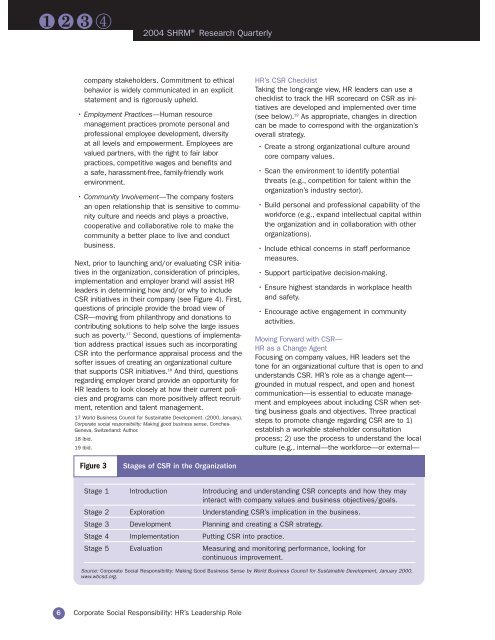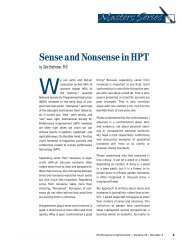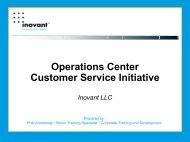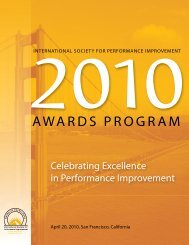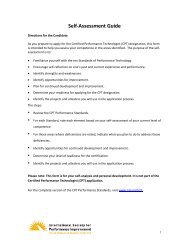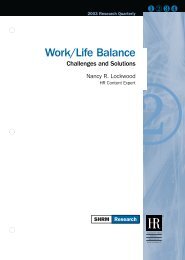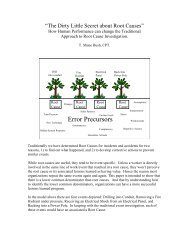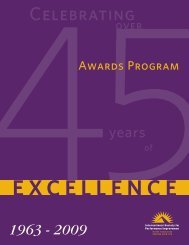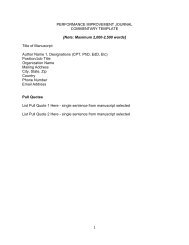Corporate Social Responsibility: HR's Leadership Role
Corporate Social Responsibility: HR's Leadership Role
Corporate Social Responsibility: HR's Leadership Role
You also want an ePaper? Increase the reach of your titles
YUMPU automatically turns print PDFs into web optimized ePapers that Google loves.
2004 SHRM® Research Quarterly<br />
company stakeholders. Commitment to ethical<br />
behavior is widely communicated in an explicit<br />
statement and is rigorously upheld.<br />
• Employment Practices—Human resource<br />
management practices promote personal and<br />
professional employee development, diversity<br />
at all levels and empowerment. Employees are<br />
valued partners, with the right to fair labor<br />
practices, competitive wages and benefits and<br />
a safe, harassment-free, family-friendly work<br />
environment.<br />
• Community Involvement—The company fosters<br />
an open relationship that is sensitive to community<br />
culture and needs and plays a proactive,<br />
cooperative and collaborative role to make the<br />
community a better place to live and conduct<br />
business.<br />
Next, prior to launching and/or evaluating CSR initiatives<br />
in the organization, consideration of principles,<br />
implementation and employer brand will assist HR<br />
leaders in determining how and/or why to include<br />
CSR initiatives in their company (see Figure 4). First,<br />
questions of principle provide the broad view of<br />
CSR—moving from philanthropy and donations to<br />
contributing solutions to help solve the large issues<br />
such as poverty. 17 Second, questions of implementation<br />
address practical issues such as incorporating<br />
CSR into the performance appraisal process and the<br />
softer issues of creating an organizational culture<br />
that supports CSR initiatives. 18 And third, questions<br />
regarding employer brand provide an opportunity for<br />
HR leaders to look closely at how their current policies<br />
and programs can more positively affect recruitment,<br />
retention and talent management.<br />
17 World Business Council for Sustainable Development. (2000, January).<br />
<strong>Corporate</strong> social responsibility: Making good business sense. Conches-<br />
Geneva, Switzerland: Author.<br />
18 Ibid.<br />
19 Ibid.<br />
HR’s CSR Checklist<br />
Taking the long-range view, HR leaders can use a<br />
checklist to track the HR scorecard on CSR as initiatives<br />
are developed and implemented over time<br />
(see below). 19 As appropriate, changes in direction<br />
can be made to correspond with the organization’s<br />
overall strategy.<br />
• Create a strong organizational culture around<br />
core company values.<br />
• Scan the environment to identify potential<br />
threats (e.g., competition for talent within the<br />
organization’s industry sector).<br />
• Build personal and professional capability of the<br />
workforce (e.g., expand intellectual capital within<br />
the organization and in collaboration with other<br />
organizations).<br />
• Include ethical concerns in staff performance<br />
measures.<br />
• Support participative decision-making.<br />
• Ensure highest standards in workplace health<br />
and safety.<br />
• Encourage active engagement in community<br />
activities.<br />
Moving Forward with CSR—<br />
HR as a Change Agent<br />
Focusing on company values, HR leaders set the<br />
tone for an organizational culture that is open to and<br />
understands CSR. HR’s role as a change agent—<br />
grounded in mutual respect, and open and honest<br />
communication—is essential to educate management<br />
and employees about including CSR when setting<br />
business goals and objectives. Three practical<br />
steps to promote change regarding CSR are to 1)<br />
establish a workable stakeholder consultation<br />
process; 2) use the process to understand the local<br />
culture (e.g., internal—the workforce—or external—<br />
Figure 3<br />
Stages of CSR in the Organization<br />
Stage 1 Introduction Introducing and understanding CSR concepts and how they may<br />
interact with company values and business objectives/goals.<br />
Stage 2 Exploration Understanding CSR’s implication in the business.<br />
Stage 3 Development Planning and creating a CSR strategy.<br />
Stage 4 Implementation Putting CSR into practice.<br />
Stage 5 Evaluation Measuring and monitoring performance, looking for<br />
continuous improvement.<br />
Source: <strong>Corporate</strong> <strong>Social</strong> <strong>Responsibility</strong>: Making Good Business Sense by World Business Council for Sustainable Development, January 2000,<br />
www.wbcsd.org.<br />
6 <strong>Corporate</strong> <strong>Social</strong> <strong>Responsibility</strong>: HR’s <strong>Leadership</strong> <strong>Role</strong>


